December 23, 2021
What can you do to prevent winter tree damage? Answer: many things!
Harm to deciduous and coniferous trees in the wintertime is preventable. Thanks to a few simple tips, you can protect your trees before they’re damaged, learn to cope with existing damage, and prevent further injury.
We’ve put together a guide on everything you need to know about tree care during the harshest season of the year.
The guide will help you understand and anticipate the causes of winter damage and everything else that goes along with it—how to prevent damage, how to recognize it, and how to deal with it after it’s happened.
To begin, here are 8 most common causes of winter tree damage.
Common causes of winter tree damage

1. Low Temperatures
A palm tree couldn’t survive life in the arctic any more than a larch could survive in Palm Springs.
When temperatures drop below normal, or when trees are planted outside their hardiness zone, they risk being damaged. A plant made for a warm climate isn’t designed for a cold environment. In other words, it hasn’t adapted to weather the storm, pun intended.
Same goes for when a frost occurs early in the season. If an area experiences a frost before trees have had the chance to acclimatize to colder weather, vulnerable trees will be at risk of injury.
Dieback
Dieback is a cold-weather injury to the branches, stems, and buds on deciduous trees. This results in a lack of budding in the spring and the ultimate loss of the affected branches.
2. Fluctuating Temperatures

While low temperatures can be dangerous for certain species of plant, fluctuating conditions can be much worse.
Trees are 50% water. Because of this, a freeze-thaw cycle can severely hurt a tree.
When temperatures go through a warming and cooling cycle, water inside a tree will thaw and freeze. Consequently, the volume of water will shrink and expand. When that happens, trees that are dried out, old, or already damaged are at risk of breakage.
Then, there’s what’s happening inside a tree.
Dormant cells inside a tree that were coaxed back to life by warmer temperatures can get killed off by the cold. Tree cell death can cause two issues: frost heaving and sunscald.
Frost heaving
Fluctuating temperatures can affect soil conditions resulting in frost heaving.
Frost heaving is when freeze-thaw cycles cause the soil around and above roots to expand and contract (as with water that we talked about a moment ago). This can leave roots exposed to the cold air killing them off.
Root tissue is especially vulnerable to below-freezing temperatures. If the air temperature drops significantly, and frost heaving occurs, the risk of harm to roots goes up significantly.
This type of root damage is especially concerning for young or recently transplanted trees.

Sunscald
Sunscald, or bark cracking, often happens on the south side of trees where temperature changes are greatest between daytime and nighttime.
Sunscalding often leads only to superficial damage. Over time, however, cracked bark can leave a tree at risk of disease and even death.
Then, there’s the question of freezing when talking about fluctuating temperatures.
3. Spring Freeze

When warmer spring weather arrives only to fool us—only kidding!—with another dramatic cool spell, trees are prone to injury. Add a hard frost or freeze and the risk of harm is compounded.
A spring freeze can be especially hazardous to your trees.
Think back to the temperature fluctuations we mentioned in the previous point.
Because spring prompts a tree to re-acclimate to warmer temperatures, a sudden, unexpected freeze could cause a great deal of damage.
Any new growth or buds that have started to appear are doomed in the face of a spring freeze.
The good news about a spring freeze is that in most cases, injury to new growth isn’t severe and won’t cause long-term damage. Frozen buds simply die off and new buds appear. At worst, harm caused by a spring freeze will mean a tree sees less growth that year.
Unless a tree is very young or fragile, harm won’t be long-lasting.
Tree cell death can also lead to other issues when combined with another familiar winter occurrence: frost.
4. Frost

As a general rule, frost doesn’t pose a threat to trees. Trees consider it a natural part of winter, so to speak.
When frost comes unexpectedly, however, or if a tree isn’t fully dormant or acclimated to the cold before a first frost, it can cause severe damage.
Frost cracks
Frost cracking, like sunscald, most often occurs on the south, or sunny, side of a tree.
Sudden temperature drops cause the outer layers of the tree to contract more rapidly than the inner layers. What you end up with are long, vertical cracks or splits along the trunk, the perfect entry point for insects and disease.
In some cases, frost can cause frost cracks. Otherwise known as radial shakes, frost cracks are something to keep an eye on. Once a crack appears after a frost, there’s a far greater chance it will reappear next year.
5. Snow & Ice
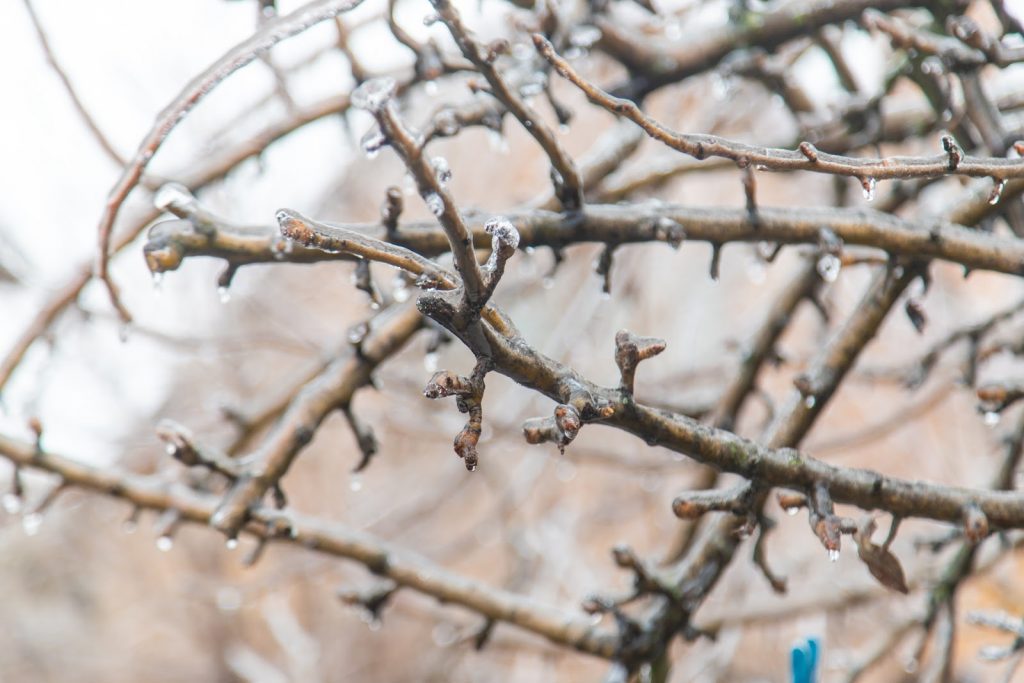
Anyone who has lived through a snow or ice storm can tell you about the damage it can do to trees.
Broken branches, split trucks, and collapsed trees can be part of the aftermath of a good ice or snow blitz.
Excessive amounts of snow or ice, which are heavy, are not friendly to trees. It’s basic physics: the more snow or ice you have on a branch, the more weight that branch has to bear. The more weight it has to bear, the greater the risk that branch will break.,
6. De-icing Salt
The use of de-icing salt is part of the deal when you live in a cold climate. Either we use salt or we risk more accidents and falls due to icy roads and sidewalks.
Trees don’t love salt as much as the soles of our shoes do, however.
Too much salt in the soil affects tree roots. Too much salt deposited on branches and twigs can kill them.
7. Lack of Water

Dry air and soil create a poor over-wintering environment for trees.
Winter drying, desiccation, or winter burn—the loss of moisture by trees, mostly evergreens, caused by freezing temperatures, low soil water content, and high winds—happens when trees are especially strapped for moisture during cold winter months.
Winter burn increases the risk of damage and even death to evergreens.
8. Animals
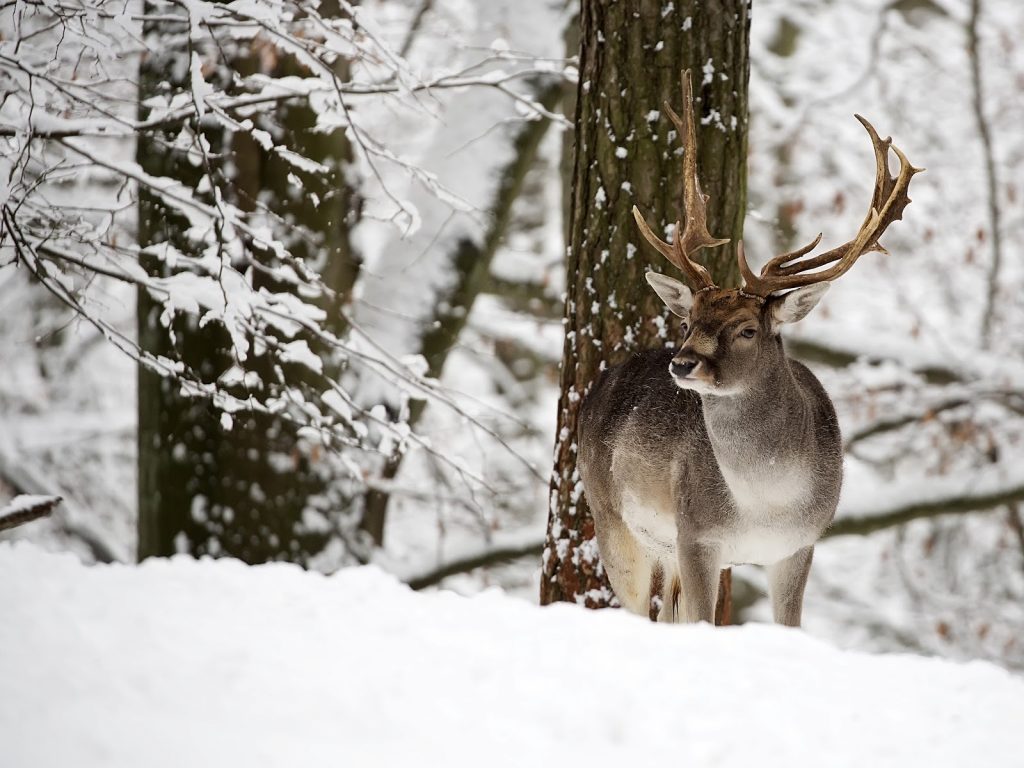
Depending on where you live, you may need to protect your trees against damage caused by wildlife.
Animals like deer, mice, and rabbits can feed on the bark or girdling of trees during the winter months when other food sources become scarce.
Rabbits and tiny rodents have the potential to harm your trees by feeding on their bark. Younger trees are especially vulnerable because their bark is thinner and more susceptible to the ravages of their smaller teeth.
Signs of winter tree damage
What should you be looking for when searching for signs of winter tree damage?
The following is a list of the most common signs of an injured tree:
- Broken branches.
- Cracked tree trunks.
- Dark brown of black foliage. Darkened leaves are normally the result of frost damage.
- Brown or dropping evergreen needs, or browning bark, all of which are signs of a lack of water in the wintertime.
- Stripped or chewed bark, tall tail (pun intended) signs of animal damage.
What to do if you notice winter tree damage
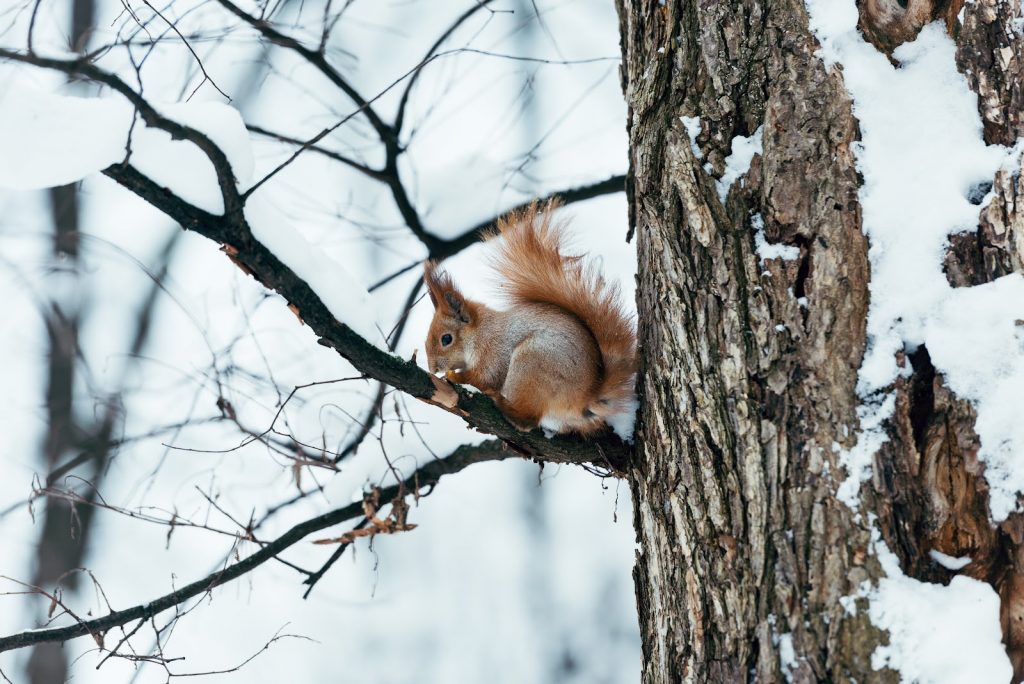
You’ve done your reconnaissance work and have identified winter tree damage; now what?
Here’s what you can do, and what you can do, once you’ve identified harm done to your tree:
- Broken branches: unless you think the broken branch is at risk of falling and causing damage or, worse, injuring a person, leave it be. Wait until spring and then get a certified arborist to remove it properly. Properly pruning dead branches will stimulate new growth—the silver lining of winter tree damage.
- Dark brown of black foliage: Resist the temptation to pull off dead leaves. Instead, wait for the browned foliage to fall off on its own. If they don’t fall on their own, have them pruned once spring arrives.
- Brown or dropping evergreen needs, or browning bark: Same goes as with browned leaves.
- Cracked tree trunks.
- Stripped or chewed bark: not much you can do here. The best plan of attack is the wait until fall and do what’s needed to protect the tree from further damage.
That last point is the perfect segway to our next section: winter tree damage prevention.
How to prevent winter tree damage
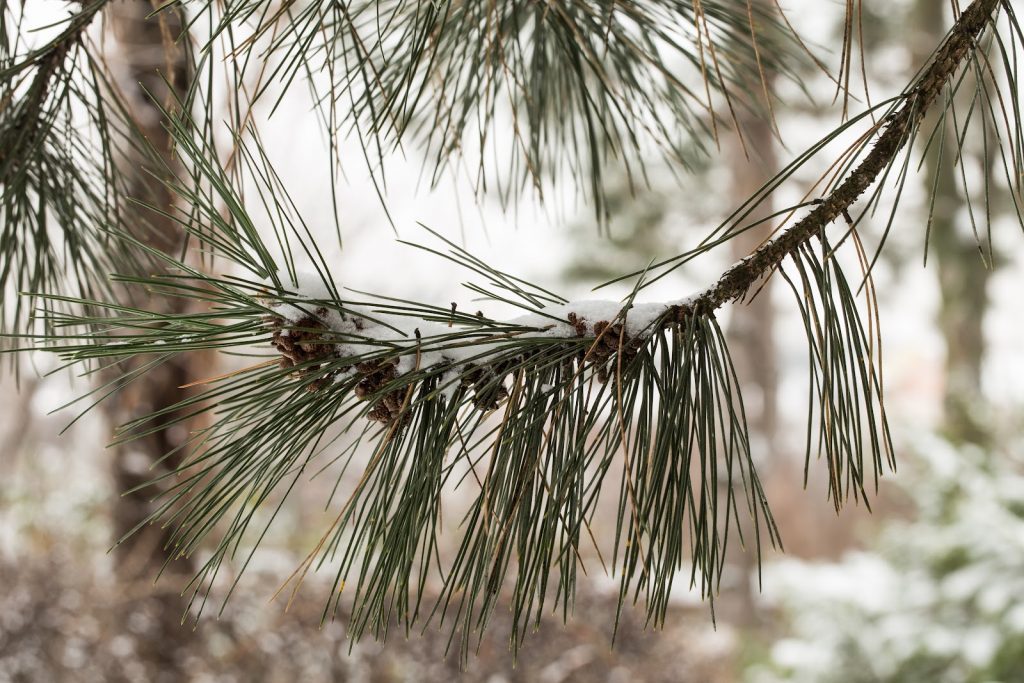
Now that we’ve covered the common causes of winter tree damage and how to recognize it, let’s talk prevention.
Here are 14 ways you can prevent damage to your trees this winter.
1. Choose Hardy Trees
The simplest thing you can do to avoid damage to trees in the wintertime is to plant the right trees for your climate.
Choose cold-hardy trees appropriate to your climate and your soil conditions. If your trees don’t meet minimum hardiness for your area, plant them in areas that are protected from wind and heavy snow, and winterize them very well.
Choose trees that are more resistant to damage and disease. Your local nursery can help you select the best species for your property.
2. Don’t plant trees in the winter
Plant your trees at the right time of year, normally in the late spring or late summer/early fall. This will ensure the tree has lots of time to lay down roots before the ground freezes.
3. Fertilize at the right time of year
There’s no sense fertilizing a plant in the winter when it’s dormant. Give your trees the nutrient boot they need to thrive through the cold weather months. Fertilize them in the spring and early summer.
4. Keep your trees well-pruned
Pruning does the same thing as fertilizing: it helps stimulate healthy plant growth.
Remove overgrowth and dead foliage with spring and winter pruning. This reduces the chance that broken parts of trees will break when weighed down by snow and ice.
Never prune in the fall. This can stimulate your trees to develop new growth, the exact opposite thing you want before they go dormant for the winter.
Not sure when it’s safe to prune? Call an arborist.
5. Mulch
Mulch is an inexpensive, easy tool to prevent winter tree damage, especially with younger and newly planted trees. Mulch protects the roots, prevents water loss, and insulates against dropping temperatures.
Mulch your evergreens and deciduous trees well before winter hits.
Having said that, keep mulch away from the base of the tree. A well-mulched trunk is a favourite spot for mice to chow down on bark. They’re protected by the mulch from predators. Moral of the story: mulch well, but not close to the trunk.
Once cold weather does hit, add layers of snow on top of the mulch to protect roots from frost and ice.
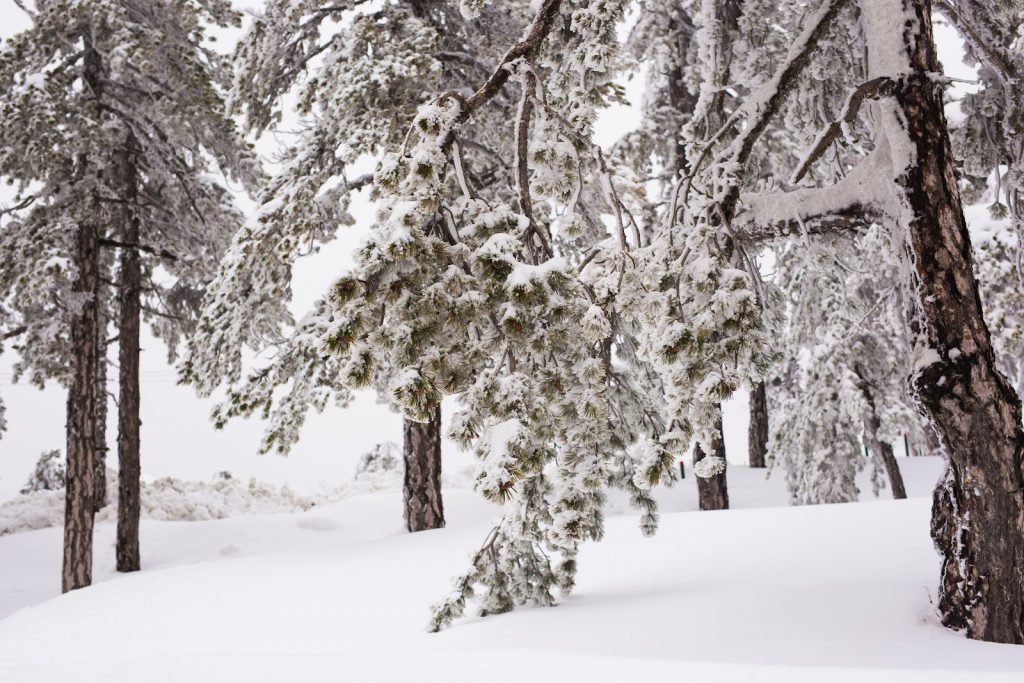
6. Cover up
Wrap vulnerable tree trunks and low branches with screen mesh, burlap, or frost blanket. This process, known as girdling, will prevent animals from reaching delicate bark and protect against frost cracking.
7. Add a straw blanket
Stuff trunks wrapped with wire mesh or burlap with straw. The extra layer will insulate your trees against fluctuating temperatures.
Do this in late fall before cold temperatures arrive and remove it in the spring to avoid your trees from overheating—and to prevent insect infestations and disease.
8. Clear!
Another technique to protect trunks from animal damage is to keep the bases of trees clear of mulch, grass, and leaves. You want to make the area as unattractive to little tree munchers as possible so they won’t be tempted to sto in for dinner.
When it comes to larger animals, like deer, it isn’t enough to wrap a trunk or clear away debris from a tree base. You may have to go the extra mile by adding fencing
9. Tie branches together
There’s strength in numbers.
Tie branches together to prevent branch breakage (say that 5 times fast!) from heavy snow and ice. Use twine or other durable material to loosely and gently tie smaller branches together.
Remember to remove the twine in the spring, however, to allow the branches to lay as they will.
10. Water, water, water
Water trees well before winter (another tongue twister!), especially evergreens. Do this until the ground freezes, especially if you have young trees.
Moreover, water your trees over the winter months. Yup, you heard that right: water your trees in the winter.
Then, you guessed it, water your trees heavily in the spring as soon as the ground thaws.
Basically, keep your tree watered.
11. Remove excess snow
When heavy snow accumulates on evergreens and deciduous trees, gently shake it off.
Bonus marks if you cover a friend or family member with the snow at the same time.
12. Watch where you put that snow
If you’re shoveling snow off of sidewalks and walkways, avoid throwing it on delicate young trees.
13. De-ice sparingly and mindfully
Use de-icing salt carefully and sparingly.
Mix it with sand or kitty litter to get the same effect without the risk of oversalianating soil.
14. Call an expert
If your area has experienced a snow or ice storm, call in an arborist to have your trees evaluated. It’s worth having an expert set of eyes on your trees to catch issues before they become serious problems.
How to show your trees love in the winter

We hope this guide on all things winter tree damage has helped you feel more comfortable about caring for your trees in the coldest of weather.
With the right care and attention, trees meant for cold climates can endure whatever nature throws at them, even if that’s a massive snowball.
Depending on the type, age, and number of trees on your property, and your willingness to care for them on their own, recognizing, preventing, and caring for winter tree damage is often best left to the professionals.
If you have a question about preventing winter tree damage, or if you suspect a tree has been harmed by our recent cold weather, give Pevach a call— we’d be happy to help.
